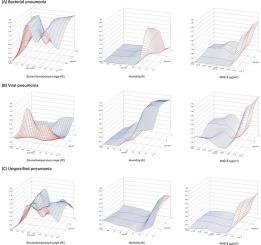Clinical Microbiology and Infection ( IF 10.9 ) Pub Date : 2020-03-14 , DOI: 10.1016/j.cmi.2020.03.006 K Huh 1 , J Hong 2 , J Jung 3

|
Objectives
Inconsistent results have been found between pneumonia and meteorological factors. We aimed to identify principal meteorological factors associated with pneumonia, and to estimate the effect size and lag time.
Methods
This was nationwide population-based study used a healthcare claims database merged with a weather database in eight metropolitan cities in Korea. We applied a stepwise approach using the Granger causality test and generalized additive model to elucidate the association between weekly pneumonia incidence (WPI) and meteorological factors/air pollutants (MFAP). Impulse response function was used to examine the time lag.
Results
In total, 2 011 424 cases of pneumonia were identified from 2007 to 2017. Among MFAP, diurnal temperature range (DTR), humidity and particulate matter ≤2.5 μm in diameter (PM2.5) showed statistically significant associations with WPI (p < 0.001 for all 3 MFAPs). The association of DTR and WPI showed an inverted U pattern for bacterial and unspecified pneumonia, whereas for viral pneumonia, WPI increased gradually in a more linear manner with DTR and no substantial decline. Humidity showed a consistent pattern in all three pneumonia categories. WPI steeply increased up to 10 to 20 μg/m³ of PM2.5 but did not show a further increase in higher concentrations. On the basis of the result, we examined the effect of MFAP in different lag times up to 3 weeks.
Conclusions
DTR, humidity and PM2.5 were identified as MFAP most closely associated with WPI. With the model, we were able to visualize the effect–time association of MFAP and WPI.
中文翻译:

气象因素和大气颗粒物与肺炎发病率的关联:生态研究。
目标
在肺炎和气象因素之间发现不一致的结果。我们旨在确定与肺炎相关的主要气象因素,并估计影响的大小和滞后时间。
方法
这项基于全国人口的研究使用了医疗保健索赔数据库与韩国八个大城市的天气数据库合并而成。我们使用格兰杰因果关系检验和广义加性模型应用了逐步分析的方法,以阐明每周肺炎发生率(WPI)与气象因子/空气污染物(MFAP)之间的关联。脉冲响应函数用于检查时滞。
结果
从2007年到2017年,总共鉴定出2 011 424例肺炎。在MFAP中,昼夜温度范围(DTR),湿度和直径≤2.5μm的颗粒物(PM 2.5)与WPI之间具有统计学意义的相关性(p <0.001所有3个MFAP)。DTR和WPI的关联显示细菌性和非特异性肺炎的倒U型,而对于病毒性肺炎,WPI与DTR呈线性关系逐渐增加,而没有实质性下降。在所有三个肺炎类别中,湿度显示出一致的模式。WPI急剧增加至PM 2.5的10至20μg/m³,但在更高的浓度下并未显示出进一步的增加。根据结果,我们检查了MFAP在长达3周的不同延迟时间内的效果。
结论
DTR,湿度和PM 2.5被确定为与WPI最密切相关的MFAP。使用该模型,我们可以可视化MFAP和WPI的效果-时间关联。











































 京公网安备 11010802027423号
京公网安备 11010802027423号